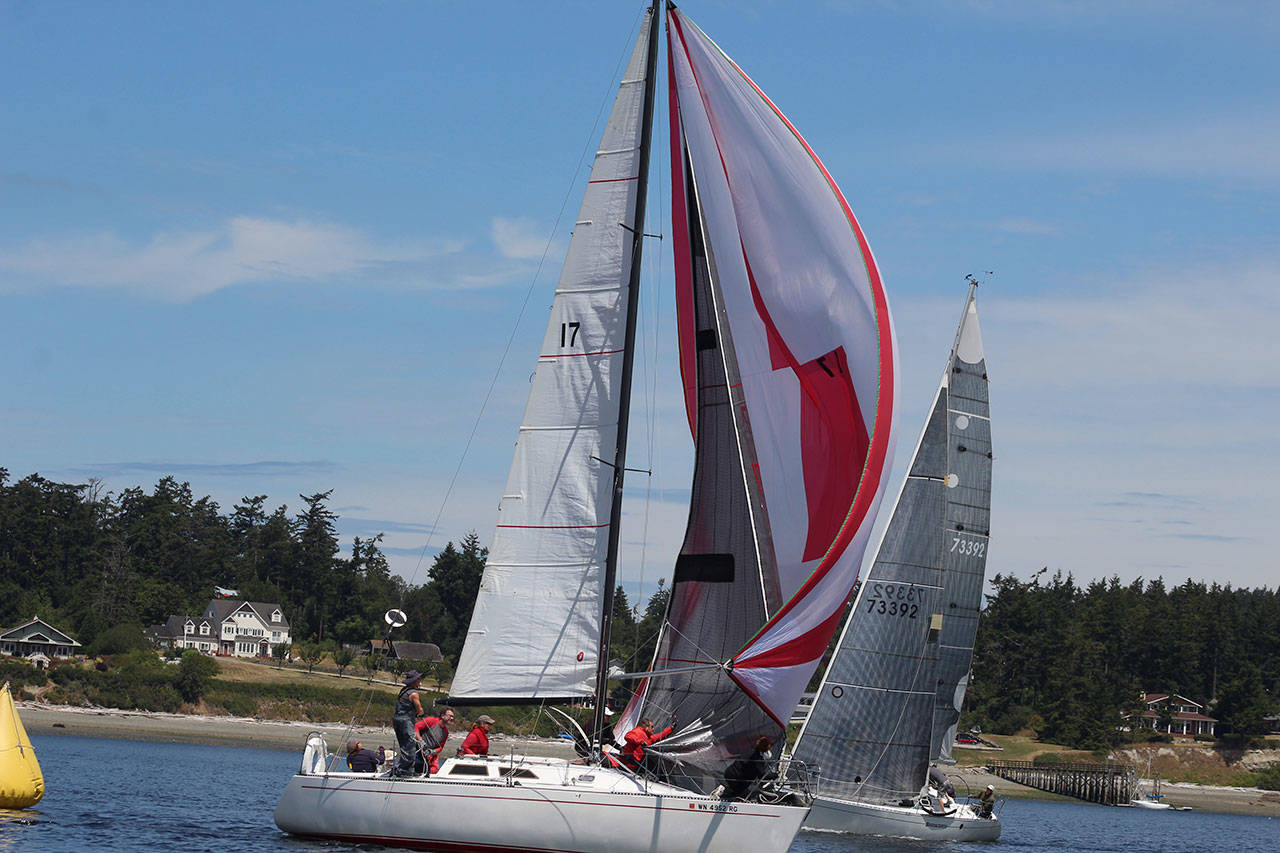It’s called a sailboat race but sounds more like a trigonometry challenge.
“YC-5 is in the middle, it’s the start boat with the official who decides which race to call,” Christine Russell explains Monday as she looks over a course diagram with sailing novices viewing the start of Whidbey Island Race Week 2017.
Russell, a longtime volunteer and racer, is zipping around in a motorized chase boat, waving to familiar captains and crew.
Boats swarm around like bees in a hive around Penn Cove not seeming to go anywhere in particular. She explains they are hovering to line up on an imaginary line that they cannot cross until race time.
The course is basically a triangular course with buoys marked at corners. Sailing into the wind during the first leg of the race requires tacking, or zig-zagging, to move forward. Rounding the buoy in a tight turn without crashing into other boats, or the buoy, is part of the challenge.
For the 35th year, Race Week brings its unique equation of wind, water, sleek sailboats and serious racers to Oak Harbor Yacht Club for daily competitions.
“Once underway, you don’t want to have all those boats around a buoy. It makes for close calls. People get bruised,” said Russell, of Mukilteo, and the twin sister of organizer Schelleen Rathkopf.
From ashore at Penn Cove, Coupeville, and other locations, Race Week doesn’t need any explanations; it’s simply gorgeous.
Dozens of yachts fly like kites, skimming over sparkling water, sometimes leaning at impossible angles.
Signaling the start, a boat horn honks around noon daily, signaling the start of another race that could fly by with strong winds or last hours if the usual perennial breeze stops.
Calm winds make for cranky sailors, said Liza Tewell, who writes a summary of events for a popular daily jam-packed newsletter “delivered” every morning.
“They’re like race horses,” she said. “They need to get out.”
Races take into the account the size and design of the 63 registered boats so even though all boats race at once, each is racing against others in the same size class of yachts.
The week-long regatta is one of the last one of its kind, said Charlie Macaulay, owner and captain of “Absolutely,” a Farr 39-foot yacht. “All the other race weeks have gone to three days. People just can’t take the time off from work; it’s tough to find crew.”
From Snoqualmie, Macaulay and his family have attended Race Week every year since its inception.
“Being an engineer, I’ve figured out I’ve spent eight months total at this event,” he joked Monday evening as racers relaxed on the grounds of Oak Harbor Yacht Club where cocktails flowed, the Canadian band “The Paperboys” played and kids and dogs formed their own circles of new friends.
Macaulay, 58, chatted with his daughter, Shelagh, 25, who said she’d been racing “forever.” When she and her sister were little, it took both of them to hoist the pole that holds the colorful spinnakers.
The tense moment-to-moment decisions during races are not the only adventure out there, Shelagh Macaulay said.
“Take engineer nerds and mix them with serious athletes, it’s quite interesting at times.”
While knowing the ways of winds and current is crucial, sailboat racing is ultimately a team sport.
“The chemistry of the crew makes the winner,” Russell said. “They have to react in an instant, there’s no time for explanations out there. Those minutes, those seconds become so critical.”
But Race Week is also a time to relax — once on land, that is.
Part fiesta and family gathering, it’s an annual reunion for those who understand the lingo of tacks, gybes, downwind legs, coming about and top marks. That’s the usual chatter at evening events, which this year includes Reggae Night, Toga Night and Gilligan’s Island Night.
“It’s an adult summer camp, and it’s been called that for years,” the elder Macaulay admitted.
• Whidbey Island Race Week 2017 lasts through Friday, with races scheduled noon to 4 p.m. daily.



